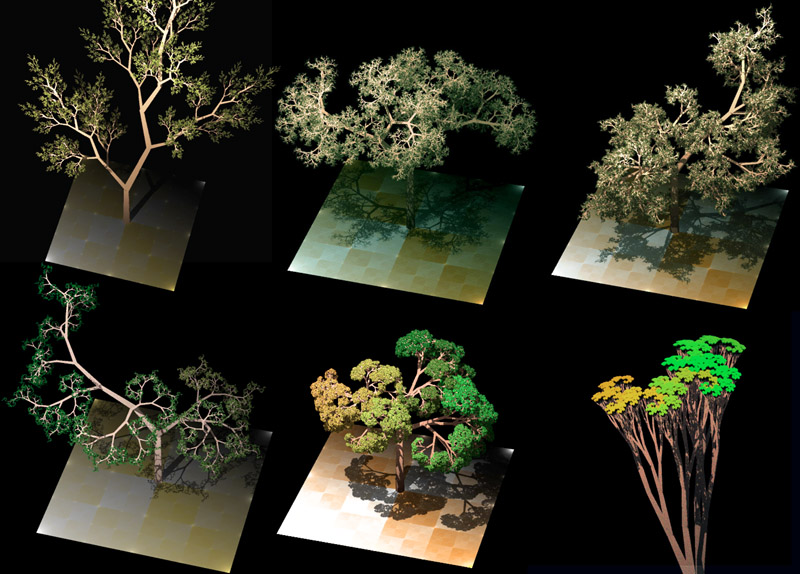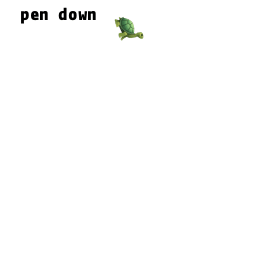|
Moore Curve
A Moore curve (after E. H. Moore) is a continuous fractal space-filling curve which is a variant of the Hilbert curve. Precisely, it is the loop version of the Hilbert curve, and it may be thought as the union of four copies of the Hilbert curves combined in such a way to make the endpoints coincide. Because the Moore curve is plane-filling, its Hausdorff dimension is 2. The following figure shows the initial stages of the Moore curve: Representation as Lindenmayer system The Moore curve can be expressed by a rewrite system (L-system). :Alphabet: L, R :Constants: F, +, − :Axiom: LFL+F+LFL :Production rules: : L → −RF+LFL+FR− : R → +LF−RFR−FL+ Here, ''F'' means "draw forward", ''−'' means "turn left 90°", and ''+'' means "turn right 90°" (see turtle graphics). Generalization to higher dimensions There is an elegant generalization of the Hilbert curve to arbitrary higher dimensions. Traversing the polyh ... [...More Info...] [...Related Items...] OR: [Wikipedia] [Google] [Baidu] |
Geometric Continuity
In mathematical analysis, the smoothness of a function is a property measured by the number of continuous derivatives it has over some domain, called ''differentiability class''. At the very minimum, a function could be considered smooth if it is differentiable everywhere (hence continuous). At the other end, it might also possess derivatives of all orders in its domain, in which case it is said to be infinitely differentiable and referred to as a C-infinity function (or C^ function). Differentiability classes Differentiability class is a classification of functions according to the properties of their derivatives. It is a measure of the highest order of derivative that exists and is continuous for a function. Consider an open set U on the real line and a function f defined on U with real values. Let ''k'' be a non-negative integer. The function f is said to be of differentiability class ''C^k'' if the derivatives f',f'',\dots,f^ exist and are continuous on U. If f is k-di ... [...More Info...] [...Related Items...] OR: [Wikipedia] [Google] [Baidu] |
Fractal Curve
A fractal curve is, loosely, a mathematical curve whose shape retains the same general pattern of irregularity, regardless of how high it is magnified, that is, its graph takes the form of a fractal. In general, fractal curves are nowhere rectifiable curves — that is, they do not have finite length — and every subarc longer than a single point has infinite length. A famous example is the boundary of the Mandelbrot set. Fractal curves in nature Fractal curves and fractal patterns are widespread, in nature, found in such places as broccoli, snowflakes, feet of geckos, frost crystals, and lightning bolts. See also Romanesco broccoli, dendrite crystal, trees, fractals, Hofstadter's butterfly, Lichtenberg figure, and self-organized criticality. Dimensions of a fractal curve Most of us are used to mathematical curves having dimension one, but as a general rule, fractal curves have different dimensions, also see also fractal dimension and list of fractals by Hausdor ... [...More Info...] [...Related Items...] OR: [Wikipedia] [Google] [Baidu] |
Space-filling Curve
In mathematical analysis, a space-filling curve is a curve whose range contains the entire 2-dimensional unit square (or more generally an ''n''-dimensional unit hypercube). Because Giuseppe Peano (1858–1932) was the first to discover one, space-filling curves in the 2-dimensional plane are sometimes called ''Peano curves'', but that phrase also refers to the Peano curve, the specific example of a space-filling curve found by Peano. Definition Intuitively, a curve in two or three (or higher) dimensions can be thought of as the path of a continuously moving point. To eliminate the inherent vagueness of this notion, Jordan in 1887 introduced the following rigorous definition, which has since been adopted as the precise description of the notion of a ''curve'': In the most general form, the range of such a function may lie in an arbitrary topological space, but in the most commonly studied cases, the range will lie in a Euclidean space such as the 2-dimensional plane (a ''pla ... [...More Info...] [...Related Items...] OR: [Wikipedia] [Google] [Baidu] |
Hilbert Curve
The Hilbert curve (also known as the Hilbert space-filling curve) is a continuous fractal space-filling curve first described by the German mathematician David Hilbert in 1891, as a variant of the space-filling Peano curves discovered by Giuseppe Peano in 1890. Because it is space-filling, its Hausdorff dimension is 2 (precisely, its image is the unit square, whose dimension is 2 in any definition of dimension; its graph is a compact set homeomorphic to the closed unit interval, with Hausdorff dimension 2). The Hilbert curve is constructed as a limit of piecewise linear curves. The length of the nth curve is \textstyle 2^n - , i.e., the length grows exponentially with n, even though each curve is contained in a square with area 1. Images File:Hilbert curve 1.svg, Hilbert curve, first order File:Hilbert curve 2.svg, Hilbert curves, first and second orders File:Hilbert curve 3.svg, Hilbert curves, first to third orders File:Hilbert curve production rules!.svg, Production rules Fi ... [...More Info...] [...Related Items...] OR: [Wikipedia] [Google] [Baidu] |
Loop (topology)
In mathematics, a loop in a topological space is a continuous function from the unit interval to such that In other words, it is a path whose initial point is equal to its terminal point.. A loop may also be seen as a continuous map from the pointed unit circle into , because may be regarded as a quotient of under the identification of 0 with 1. The set of all loops in forms a space called the loop space of . See also *Free loop *Loop group *Loop space *Loop algebra *Fundamental group *Quasigroup In mathematics, especially in abstract algebra, a quasigroup is an algebraic structure resembling a group in the sense that "division" is always possible. Quasigroups differ from groups mainly in that they need not be associative and need not have ... References Topology es:Grupo fundamental#Lazo {{topology-stub ... [...More Info...] [...Related Items...] OR: [Wikipedia] [Google] [Baidu] |
Hausdorff Dimension
In mathematics, Hausdorff dimension is a measure of ''roughness'', or more specifically, fractal dimension, that was first introduced in 1918 by mathematician Felix Hausdorff. For instance, the Hausdorff dimension of a single point is zero, of a line segment is 1, of a square is 2, and of a cube is 3. That is, for sets of points that define a smooth shape or a shape that has a small number of corners—the shapes of traditional geometry and science—the Hausdorff dimension is an integer agreeing with the usual sense of dimension, also known as the topological dimension. However, formulas have also been developed that allow calculation of the dimension of other less simple objects, where, solely on the basis of their properties of scaling and self-similarity, one is led to the conclusion that particular objects—including fractals—have non-integer Hausdorff dimensions. Because of the significant technical advances made by Abram Samoilovitch Besicovitch allowing computation of di ... [...More Info...] [...Related Items...] OR: [Wikipedia] [Google] [Baidu] |
Rewriting
In mathematics, computer science, and logic, rewriting covers a wide range of methods of replacing subterms of a well-formed formula, formula with other terms. Such methods may be achieved by rewriting systems (also known as rewrite systems, rewrite engines, or reduction systems). In their most basic form, they consist of a set of objects, plus relations on how to transform those objects. Rewriting can be non-deterministic algorithm, non-deterministic. One rule to rewrite a term could be applied in many different ways to that term, or more than one rule could be applicable. Rewriting systems then do not provide an algorithm for changing one term to another, but a set of possible rule applications. When combined with an appropriate algorithm, however, rewrite systems can be viewed as computer programs, and several automated theorem proving, theorem provers and declarative programming languages are based on term rewriting. Example cases Logic In logic, the procedure for obtaini ... [...More Info...] [...Related Items...] OR: [Wikipedia] [Google] [Baidu] |
L-system
An L-system or Lindenmayer system is a parallel rewriting system and a type of formal grammar. An L-system consists of an alphabet of symbols that can be used to make strings, a collection of production rules that expand each symbol into some larger string of symbols, an initial "axiom" string from which to begin construction, and a mechanism for translating the generated strings into geometric structures. L-systems were introduced and developed in 1968 by Aristid Lindenmayer, a Hungarian theoretical biologist and botanist at the University of Utrecht. Lindenmayer used L-systems to describe the behaviour of plant cells and to model the growth processes of plant development. L-systems have also been used to model the morphology of a variety of organisms and can be used to generate self-similar fractals. Origins As a biologist, Lindenmayer worked with yeast and filamentous fungi and studied the growth patterns of various types of bacteria, such as the cyanobacteria '' Anabaena ... [...More Info...] [...Related Items...] OR: [Wikipedia] [Google] [Baidu] |
Turtle Graphics
In computer graphics, turtle graphics are vector graphics using a relative cursor (the "turtle") upon a Cartesian plane (x and y axis). Turtle graphics is a key feature of the Logo programming language. Overview The turtle has three attributes: a location, an orientation (or direction), and a pen. The pen, too, has attributes: color, width, and on/off state (also called ''down'' and ''up''). The turtle moves with commands that are relative to its own position, such as "move forward 10 spaces" and "turn left 90 degrees". The pen carried by the turtle can also be controlled, by enabling it, setting its color, or setting its width. A student could understand (and predict and reason about) the turtle's motion by imagining what they would do if they were the turtle. Seymour Papert called this "body syntonic" reasoning. A full turtle graphics system requires control flow, procedures, and recursion: many turtle drawing programs fall short. From these building blocks one can build ... [...More Info...] [...Related Items...] OR: [Wikipedia] [Google] [Baidu] |
Moore Curves 3D
Moore may refer to: People * Moore (surname) ** List of people with surname Moore * Moore Crosthwaite (1907–1989), a British diplomat and ambassador * Moore Disney (1765–1846), a senior officer in the British Army * Moore Powell (died c. 1573), a Welsh politician * Gordon Moore, (1929-), co-founder of Intel, coined the term "Moore's Law" Places Australia *Moore, Queensland, a town in the Somerset Region *Division of Moore, an electoral division in Western Australia Greenland *Moore Glacier United Kingdom *Moore, Cheshire, England United States * Moore, Idaho *Moore, Indiana * Moore, Montana * Moore, New Jersey *Moore, Oklahoma *Moore Township, Pennsylvania *Moore, South Carolina *Moore, Texas *Moore, Utah *Moore, Washington * Moore, West Virginia *Moore County, North Carolina *Moore County, Tennessee *Moore County, Texas *Moore Haven, Florida * Banning, California, formerly known as Moore City Schools Australia * Moore Theological College, Sydney, Australia Uni ... [...More Info...] [...Related Items...] OR: [Wikipedia] [Google] [Baidu] |
Gray Code
The reflected binary code (RBC), also known as reflected binary (RB) or Gray code after Frank Gray, is an ordering of the binary numeral system such that two successive values differ in only one bit (binary digit). For example, the representation of the decimal value "1" in binary would normally be "" and "2" would be "". In Gray code, these values are represented as "" and "". That way, incrementing a value from 1 to 2 requires only one bit to change, instead of two. Gray codes are widely used to prevent spurious output from electromechanical switches and to facilitate error correction in digital communications such as digital terrestrial television and some cable TV systems. Motivation and name Many devices indicate position by closing and opening switches. If that device uses natural binary codes, positions 3 and 4 are next to each other but all three bits of the binary representation differ: : The problem with natural binary codes is that physical switches are not ideal ... [...More Info...] [...Related Items...] OR: [Wikipedia] [Google] [Baidu] |




